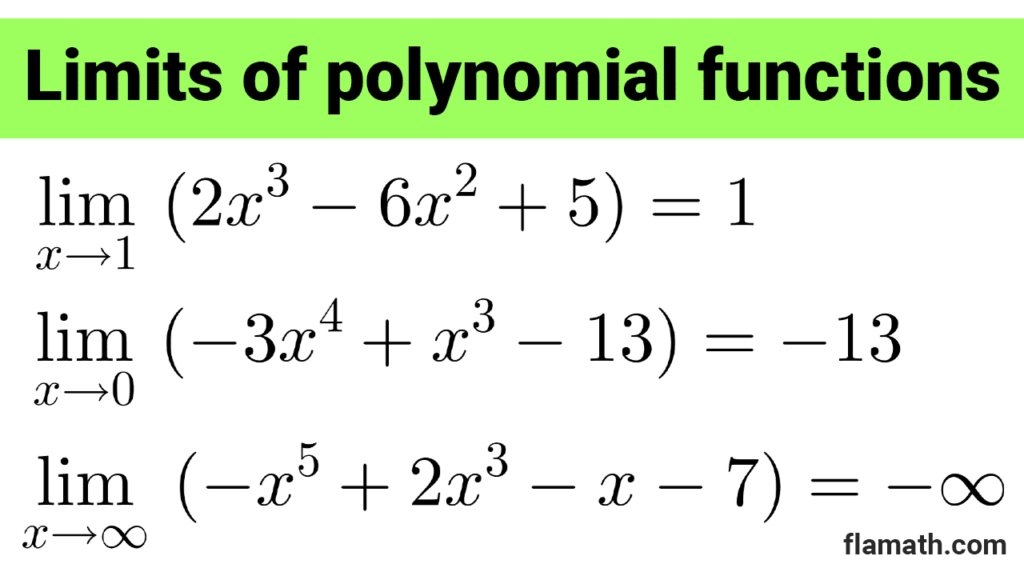
Limits of Polynomial Functions
In this article, we study the limits of a polynomial function both at a point and at positive and negative infinity.
Let's recall that a polynomial function is a real function of the form *f(x)=a_n x^n+a_{n-1}x^{n-1}+...+a_1x+a_0,* where *a_0,a_1,a_2,....,a_{n-1},a_n* are real numbers, and all exponents are natural numbers. The domain of a polynomial function is the set of real numbers, that is, *D_f=\mathbb{R}.*
Table of Contents
Limit at a point
The limit of a polynomial function at a point is equal to the value of the function at that point.
Let the polynomial function be *f(x)=a_n x^n+a_{n-1}x^{n-1}+...+a_1x+a_0* with *D_f=\mathbb{R},* then:
$$\lim_{x\to p} f(x)=f(p)=a_n(p)^n+a_{n-1}(p)^{n-1}+...+a_1(p)+a_0$$
Examples:
*\lim_{x\to 1} ~(2x^3-6x^2+5)=2(1)^3-6(1)^2+5=1*
*\lim_{x\to -2} ~(-x^5+2x^3-x-1)=-(-2)^5+2(-2)^3-(-2)-1=17*
*\lim_{x\to 0} ~(-3x^4+x^3-13)=-3(0)^4+(0)^3-13=-13*
Limits at infinity
The limit of a polynomial function as the independent variable approaches positive infinity is positive infinity (if the leading coefficient is positive) or negative infinity (if the leading coefficient is negative). In symbols:
$$\lim_{x\to \infty} f(x)=+\infty~~\text{if}~~a_n>0$$
$$\lim_{x\to \infty} f(x)=-\infty~~\text{if}~~a_n<0$$
Recall that the leading coefficient of a polynomial is the number multiplying the *x* with the highest power.
Examples:
*\lim_{x\to \infty} ~(2x^3-6x^2+5)=+\infty* because the leading coefficient is *2>0*
*\lim_{x\to \infty} ~(-x^5+2x^3-x-7)=-\infty* because the leading coefficient is *-1<0*
The limit of a polynomial function as the independent variable approaches negative infinity is:
- Positive infinity, if the leading coefficient is positive and the degree is even or if the leading coefficient is negative and the degree is odd.
- Negative infinity, if the leading coefficient is negative and the degree is even or if the leading coefficient is positive and the degree is odd.
In symbols:
*\lim_{x\to -\infty} f(x)=+\infty* if *a_n>0* and *n* is even
*\lim_{x\to -\infty} f(x)=+\infty* if *a_n<0* and *n* is odd
*\lim_{x\to -\infty} f(x)=-\infty* if *a_n<0* and *n* is even
*\lim_{x\to -\infty} f(x)=-\infty* if *a_n>0* and *n* is odd
It is not convenient to memorize these cases but to understand the logic behind them. It can be shown that the limit of a polynomial function as the variable takes very large positive or negative values depends on the leading coefficient. That is:
$$\lim_{x\to \infty} ~(a_n x^n+a_{n-1}x^{n-1}+...+a_1x+a_0)=\lim_{x\to \infty} a_nx^n$$
$$\lim_{x\to -\infty} ~(a_n x^n+a_{n-1}x^{n-1}+...+a_1x+a_0)=\lim_{x\to -\infty} a_nx^n$$
For example: *\lim_{x\to \infty} ~(5x^7+3x^5-x^3+6x^2-x+1)=\lim_{x\to \infty} 5x^7*
This is because, for very large numbers, the leading coefficient contributes the most to the value of the function.
When the variable takes very large negative values but is raised to an even power, the number will be positive. Then, the sign will depend on the coefficient accompanying the variable: if it is positive, the result will be positive; if it is negative, the result will be negative.
Examples:
*\lim_{x\to -\infty} ~(-3x^4+x^3-13)=\lim_{x\to -\infty} -3x^4=-\infty* because the coefficient is negative, and the highest power is even.
To understand it better: *\lim_{x\to -\infty} -3x^4=-3(-\infty)^4=-3\cdot \infty=-\infty*
*\lim_{x\to -\infty} ~(6x^2+x+4)=\lim_{x\to -\infty} 6x^2=+\infty* because *6(-\infty)^2=6\cdot \infty=\infty*
On the other hand, when the variable takes very large negative values and is raised to an odd power, the resulting number still retains the negative sign. Therefore, it will be necessary to study the value of the coefficient: if it is negative, the result will be positive (negative times negative is positive); if it is positive, the result will be negative (positive times negative is negative).
Examples:
*\lim_{x\to -\infty} ~(2x^3-6x^2+5)=\lim_{x\to -\infty} 2x^3=2(-\infty)^3=2(-\infty)=-\infty*
*\lim_{x\to -\infty} ~(-x^5+2x^3-x-7)=\lim_{x\to -\infty} -x^5=-(-\infty)^5=-(-\infty)=+\infty*


Other articles that may interest you